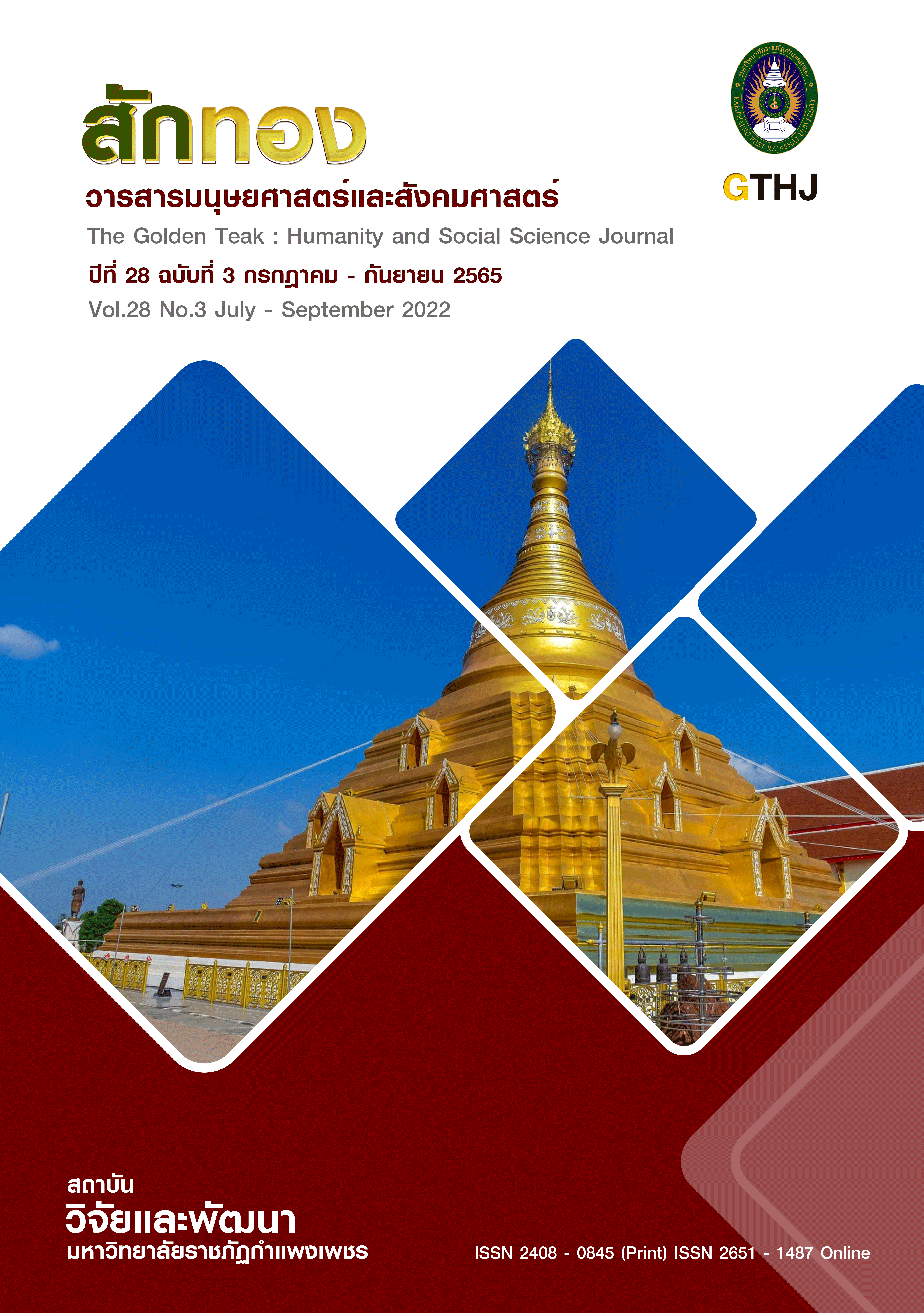Research Article Tourism Components that influence Decision Making to Travel Natural and Cultural Tourism of Chinese Tourists in Wuzhen City, Zhejiang Province, People’s Republic of China Tourism Components that influence Decision Making to Travel Natural and Cultural Tourism of Chinese Tourists in Wuzhen City, Zhejiang Province, People’s Republic of China
Main Article Content
Abstract
The purpose of this independent study were: (1) To study the opinion level environment and tourism motivation, public transport system, quality of accommodation, tourism activities management, various facilities of cultural and natural and Chinese tourists decision-making in Wuzhen. (2) to study Tourism Components that influence Decision Making to Travel Natural and Cultural Tourism of Chinese Tourists in Wuzhen City, Zhejiang Province, People’s Republic of China. The sampling group of Wuzhen tourists, consisting of 384 peoples. The tool is a questionnaire with descriptive statistics, percentage, average, standard deviation and inferential statistics by Multiple regression analyzed, Enter Selection technique. The outcomes of independent study revealed that the opinions level of environment and tourism motivation and tourists decision-making equal proportion (mean=3.64), tourism activities management (mean=3.63), Public transport system (mean=3.60),Various facilities (mean=3.59) and the last quality of the accommodation (mean=3.55). These factors were valued as most level. The outcomes of multiple regression analysis that the tourism activities management had direct effect toward tourists decision making, coefficient equal to 0.305, and followed by environment and tourism motivation had direct effect toward tourists decision-making, coefficient equal to 0.220, public transport system had direct effect toward tourists decision-making, coefficient equal to 0.152, various facilities had direct effect toward tourists decision-making, coefficient equal to 0.151by all factors were significant at 0.05. Accepted quality of accommodation had not direct effect toward tourists decision-making.
Article Details

This work is licensed under a Creative Commons Attribution-NonCommercial-NoDerivatives 4.0 International License.
บทความที่ได้รับการตีพิมพ์เป็นลิขสิทธิ์ของวารสาร สักทอง : วารสารมนุษยศาสตร์และสังคมศาสตร์ สถาบันวิจัยและพัฒนา มหาวิทยาลับราชภัฏกำแพงเพชร
ข้อคิดเห็นใดๆ ที่ปรากฎในวารสารเป็นวรรณกรรมของผู้เขียนโดยเฉพาะ ซึ่งมหาวิทยาลัยราชภัฏกำแพงเพชรและบรรณาธิการไม่จำเป็นต้องเห็นด้วย
References
Buhalis, D. (2000). Marketing the competitive destination of the future. Tourism Management. 21(1), 97- 116.
China Business Network.(2020). CYTS releases 2019 annual report. [Online] Available :
http://www.nmwhtv.com/xinwen/jiaodian/2020/0428/51243.html. [2020, December, 23].
China State Council Information Office website. (2020). Hubei Province COVID-19 Prevention Work Press Conference 46th. [Online] Available : http://www.scio.gov.cn/xwfbh/gssxwfbh/xwfbh/hubei/Document/1675446/1675446.htm. [2020, December, 23].
China Tourism Academy. (2019). The Basic Situation of the Tourism Marketing. [Online] Available : https://www.mct.gov.cn/whzx/whyw/202003/t20200310_851786.htm [2020, December, 23].
Cooper, C. , & Boniface, B. G. (1998). Geography of Travel and Tourism. UK: Butterworth Heinemann.
Dickman, S. (1996). Tourism: An Introductory Text. Sydney : Hodder Education.
Embassy of the People’s Republic of CHINA the Kingdom of Thailand. (2020). Ministry of Foreign Affairs of The People's Republic of China National Immigration Administration Announcement on Entry by Foreign Nationals Holding Valid Chinese Residence Permits of Three Categories. [Online] Available : http://www.chinaembassy.or.th/eng/ggl/t1818403.htm. [2020, September 25].
Gursoy, D. & McCleary, K. W. (2004). Travelers’ Prior Knowledge and its Impact on their Information Search Behavior. [Online] Available : https://journals.sagepub.com/doi/10.1177/1096348003261218# [2020, February, 24].
Khan, A. , Bibi, S. , Lorenzo, A. Lyu, J. , & Babar, Z. U. (2020). Tourism and Development in Developing Economies: A Policy Implication Perspective. [Online] Available : https://www.mdpi.com/2071-1050/12/4/1618. [2020, October, 2].
Krejcie, R. V. , & Morgan, D. W. (1970). Determining Sample Size for Research Activities. Educational and Psychological Measurement, 30(3), 607-610.
Likert, R. (1967). “The Method of Constructing and Attitude Scale”, Theory and Measurement. New York : John Wiley & Son.
Marcouiller, D. (1998). Environmental resources as latent primary factors of production in tourism : The case of forest-based commercial recreation. Tourism Economics, 15 (4), 131-145.
Ministry of Culture and Tourism of The People’s Republic of China. (2020). Stimulate tourists' consumption potential. Online Available : https//www.mct.gov.cn/whzx/qgwhxxlb/hn/202008/t20200826_874358.htm. [2020, December, 23].
Power, T. (1988). The economic pursuit of quality. Armonk: M. E. Sharpe.
Puad Mat Som, A. , & Ader, B. M. (2011). Tourist satisfaction and repeat visitation: Toward a new comprehensive model. International Journal of Human and Social Sciences, 6(1), 38-45.
Sina Finance. (2020). There will be no increase in passenger flow in the scenic area in 2019, and the industry will face a trough in 2020. [Online] Available : https://finance.sina.com.cn/stock/relnews/cn/2020-04-10/doc-iirczymi5476588.shtml. [2020, December, 23].
Swarbrooke, J. , & Horner, S. (2007). Consumer Behaviour in Tourism. (2nd ed.). Butterworth-Heinemann, The Netherlands.
Tourism Western Australia. (2008). 5A’s of Tourism. [Online] Available : http://www.tourism.wa.gov.au/jumpstartguide/totb_5Asoftourism.html. [2020, December, 23].
Wu, Q. G. (2006). Tourism Consumer Behavior. Beijing : Tourism Education Press.
Wuzhen Tourism Website. (2019). Wuzhen background introduction. [Online] Available : http://www.wuzhen.com.cn/web/introduction?id=2. [2020, December, 23]


